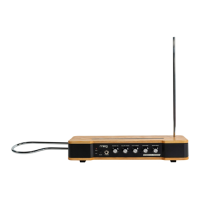24
CONTROLLING MOOG SYNTHESIZERS
Etherwave Theremin is an ancestor to the synthesizer and uses Voltage Control to operate. As such,
Etherwave Theremin can connect to and interface with modular and semi-modular synthesizers—or
really any musical or audio device allowing for Voltage Control. This concept of Voltage Control (VC) is
central to the development of the synthesizer and to electronic music in general.
HOW IT WORKS
A Control Voltage is an analog signal of a specific or changing voltage generated by one synthesizer—
or other electronic instrument—that is used to control another synthesizer or synthesizer module.
There are dierent types of control signals: there are control signals that provide a variable range of
voltage values, and there are other signals that act more as an on/o control, such as a gate. Think
of what happens when a note is played on an analog synthesizer. First, a gate signal is created for as
long as the key is held down. Secondly, a voltage is created that corresponds to the key being played;
this voltage tells the oscillator what pitch to sound. But this same voltage can be used to modify the
filter brightness, the envelope release time, etc. On a modern velocity-sensing keyboard, an additional
Control Voltage is created based on the velocity used to play the key. Sharing these control signals
between instruments, modules, and/or Eurorack systems is how one expands the capabilities of their
rig. These Control Voltage signals can be used collectively in playing another instrument in its entirety,
or patched individually in order to aect changes to dierent parameters on dierent components
and even dierent instruments.
Using Etherwave Theremin to control other modules and instruments can provide amazing levels of
expression. Moog semi-modular instruments are excellent expanders for your Etherwave Theremin.
ETHERWAVE THEREMIN CONTROL SIGNALS
While performing, Etherwave Theremin creates three distinct control signals that can be used with
other voltage-controllable modules or instruments. These three control signals are sent via a set of
dedicated 3.5mm (TS) jacks located on the rear panel. Using patch cables, connect these control
signal outputs to control signal inputs on any modular, semi-modular, or Eurorack synthesizer.
PITCH CV OUT (–2.5V to +4.5V)
The Control Voltage signal available from this jack corresponds to the pitch of
the note being played by Etherwave Theremin—as determined by the setting
of the PITCH RANGE knob and the movement of the right hand in proximity
to the Pitch Antenna. The value of this signal is set from the factory to provide
zero volts (0V) when playing the note C3 (the note one octave below Middle C).
The value increases at a rate of one volt per octave (1V/OCT), meaning that
playing Middle C would create a value of one volt, playing the note C one
octave above that would create a value of two volts, etc.
The voltage value available via this jack is derived from the pitch being played,
and can be used to set the value of the pitch being played by another module
or synthesizer. Keep in mind that Etherwave Theremin can generate not just
notes, but continuous changes in pitch as well as true vibratos. This control
signal can also be used to control any other parameter that can be voltage
controlled—envelope timing, filter resonance, oscillator mix, noise amount, etc.

